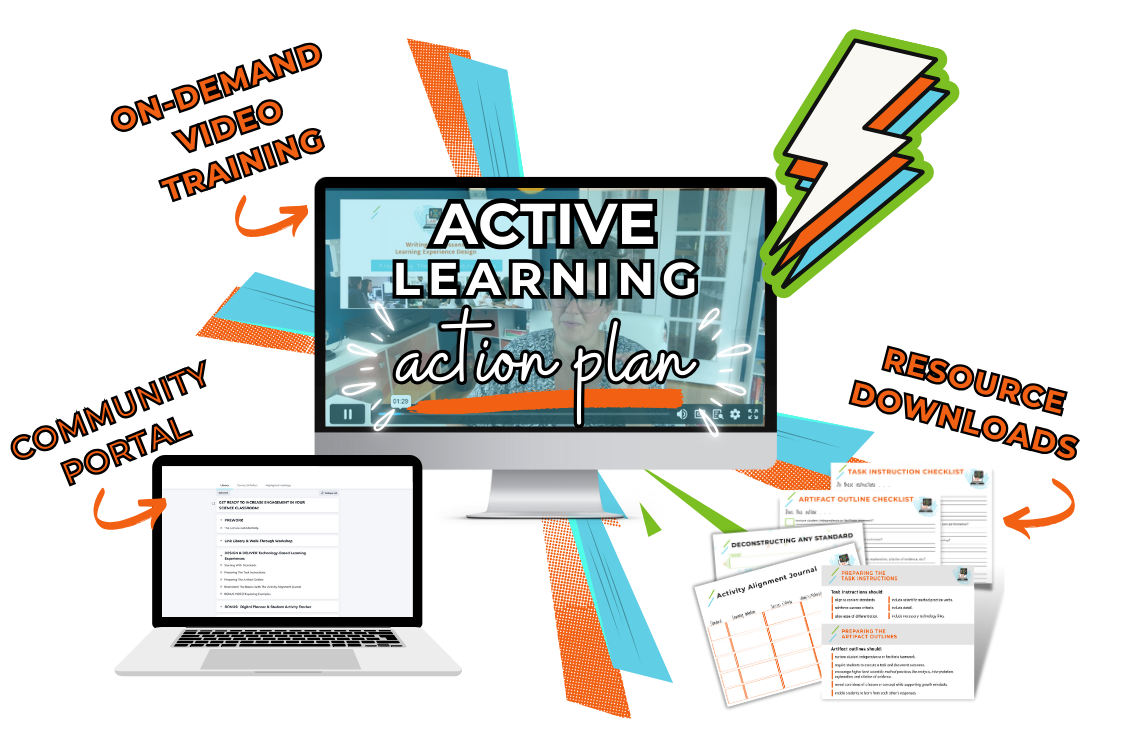You just finished teaching a lesson and you’re feeling really great about it. You’ve led a discussion and engagement was okay. You’re sure your students are “getting it” so you try to go deeper. You ask, “WHY?” …. and you’re met with silence!
When I used to teach abstract concepts like the octet rule before using student-centered instructional strategies, I was left frustrated and frazzled. I struggled with how to lead my students from simply recalling information to truly applying their understanding in meaningful ways.
Then I found that developing and using models drives the depth we’re trying to achieve! It’s a cornerstone of inquiry-based chemistry that not only helps students visualize complex ideas but also strengthens their ability to reason with evidence.
In this article, I’ll walk you step-by-step through a detailed lesson plan for teaching the octet rule using student-centered, inquiry-based strategies that align with the modern, 3-dimensional expectations outlined by the NGSS. You’ll learn how to integrate modeling into your instruction, provide opportunities for students to connect concepts with evidence, and deliver activities that shift the responsibility of learning onto them.
By the end of this article, you’ll have all the tools you need to transform your most challenging or fundamental lessons (like the octet rule in chemistry) into an engaging and thought-provoking experience—one that equips your students with the skills to reason, explore, and explain with confidence.
Read on or watch the video:
Table of Contents
- How Developing and Using Models Enhances This Octet Rule Lesson
- A Lesson Planning Framework for Inquiry-Based Chemistry and NGSS Chemistry
- Key Features of This Lesson Related to Developing and Using Models
- Design and Delivery Tips For This Inquiry-Based Chemistry lesson
- Suggestions For Differentiating This Inquiry-Based Chemistry Lesson About The Octet Rule
How Developing And Using Models Enhances This Octet Rule Lesson
As science teachers, we hold a unique responsibility: to help students uncover core ideas and develop skills that extend beyond the classroom.
Teaching the octet rule offers the perfect opportunity to align our instruction with inquiry-based learning by placing students at the center of the discovery process. This lesson isn’t about memorizing facts or rote practice—it’s about creating meaningful opportunities for students to observe, analyze, and reason with evidence.
My approach to teaching the octet rule is centered upon developing and using models, one of the NGSS science and engineering practices, as the foundation for exploration and arguing from evidence.
This strategy helps students visualize abstract concepts, like why atoms gain or lose electrons, while also reinforcing critical reasoning skills. By focusing on cause and effect, structure and function, and other NGSS cross-cutting concepts, this inquiry-based chemistry lesson is designed to bring the octet rule to life in a way that’s actionable, relevant, and engaging.
A Lesson Planning Framework for Inquiry-Based Chemistry and NGSS Chemistry
This inquiry-based, NGSS-aligned octet rule lesson follows a five-step framework designed to guide students through the learning process:

REVIEW & PREVIEW (warmup / bellringer)
The lesson begins with a review of foundational concepts, activating prior knowledge and preparing students for new content. Students revisit the relationship between atomic models and periodic table patterns.
Learning Intentions and Success Criteria (Lesson objectives)
Students are introduced to learning intentions that reflect the NGSS standard we’re addressing. A list of success criteria help students measure their participation and learning outcomes, providing confidence and direction as they progress through the lesson. They also help teachers lead their lessons!
OBSERVATION-focused Activity
All science begins with observations. It’s my experience that when we focus students’ attention on what they can gather instead of what they already know as they begin an exploration, the more confident engagement we’ll get from them!
In this octet rule lesson, students observe neutral Bohr models, developing and using these models to predict how their outermost orbitals will change according to the octet rule.
data-dependent analysis
From developing and using models in this way, students will have produced evidence that will allow them to extract patterns and other underlying cross-cutting concepts in science, an expectation of more modern, 3-dimensional approaches to science instruction.
In this octet rule lesson, students will produce evidence to show that every atomic model for an atom (i.e. Bohr model, orbital diagram model, and electron configuration) that has had its outermost orbital of electrons filled or removed matches that of a noble gas atom. They’ll then be able to use the periodic table to make predictions about atoms’ octets without drawing models.
Formative assessment and Skill Practice
Once students have uncovered the core ideas of the lesson, they practice applying their knowledge to various examples or scenarios to reinforce their mastery of the concepts.
This structure ensures students actively engage with the material at every step, moving beyond surface-level understanding to develop deeper insights.
Key Features Of This Lesson Related To Developing And Using Models
What makes this octet rule lesson different from any other is its emphasis on student-centered, inquiry-based learning.

These are some of the key features that make it both engaging and effective:
GUIDED INQUIRY DELIVERY OF DEVELOPING AND USING MODELS
Students begin by considering the following:
- instability of atoms with different numbers of valence electrons
- how gaining or losing electrons impacts stability
- the energetic cost of gaining more or losing all they’ve got
By providing all the same models in the warmup activity as those required by the main activity and using specific prompts to guide students’ decision making about further developing and using models to enhance their critical thinking, students also naturally consider the cause and effect nature of the process. We’re getting them deep into the “why” behind the octet rule as they seek to uncover the core ideas related to “how” this is accomplished in nature.
NGSS Cross-Cutting Concepts
This lesson incorporates multiple (dare I say ALL 7?!) NGSS cross-cutting concepts in science.
Among the most prominent are the following:
Cause and Effect
Students explore how the instability of an atom drives electron gain or loss.
Scale, Proportion, and Quantity
Students consider how many electrons exist in the outermost orbitals of neutral atoms and how many are needed to achieve the stability of an octet.
Structure and Function
The lesson emphasizes how the number of valence electrons influences an element’s reactivity.
Systems and System Models
Since developing and using models is the primary science and engineering practice at play in this lesson, students view each atom as a system within which every electron contributes to its stability.
Patterns
By the end of the lesson, students recognize that metals and nonmetals achieve stability in predictable ways and how to use the periodic table to make those predictions.
For a detailed analysis on how the cross-cutting concepts in science are integrated into this lesson, check out my article entitled, “These NGSS Cross-Cutting Concepts Will Make Your Octet Rule Worksheets Outstanding! “.
Student-centered focus on developing and using models
Throughout the activity, students are encouraged to ask quality questions about the models they are developing and using. This reinforces NGSS science and engineering practices and cultivates critical thinking.
By integrating these features, this lesson ensures students aren’t just learning the octet rule—they’re developing essential skills like reasoning, problem-solving, and evidence-based thinking. Most importantly, though, the design is very student-centered. It doesn’t require the teacher to do the work by talking through the models while demonstrating.
The active learning principles at work here ensure that student engagement is meaningful; students are aware at every phase of the lesson that they own their progress and the potential for mastery.
Design and Delivery Tips For This Inquiry-Based Chemistry lesson
Now that you know a great deal more about the intentional design of this octet rule lesson for NGSS chemistry or inquiry-based chemistry classrooms, let’s look at portions of the actual lesson to provide supporting evidence for why this lesson works so well to keep the expectation for rigor high without losing any student engagement.
Even if you teach a science other than chemistry, you’ll glean a lot from the design and delivery tips included here!
Prior Knowledge Required For Developing and Using Models In This Octet Rule Lesson
Before diving into the octet rule lesson, it’s critical that students have a strong foundation of prior knowledge to ensure they can successfully engage in developing and using models during the observation activity.

The key topics and skills students should master before delivering this lesson include the following:
Periodic Trends in Atomic Radius and Ionization Energy
How the number of orbitals influences the size of an atom is critical for students to recall prior to engaging with this lesson because students will be developing atomic models with one less orbital or filling up an existing orbital. Plus, the periodic trend of ionization energy is directly tied to this concept, as well. Since application of octet rule knowledge will produce cations and anions, we’ll want students to use both atomic radius and ionization energy as further evidence and reasoning to support the models they propose.
The Bohr Model, Filling Orbital Diagrams, and Writing Electron Configurations
The model-based nature of this lesson requires that students understand the behavior, location, and energy of electrons in various models including the Bohr model, orbital diagrams, and electron configurations.
Periodic Patterns in Electron Configurations
Students should be familiar with the s, p, d, and f-blocks of the periodic table.
A Scope and Sequence For Inquiry-Based Chemistry Instruction
All these lessons contribute to instruction on NGSS HS-PS-1: “Using the periodic table as a model to predict the relative properties of elements based on the patterns of electrons in the outermost energy level of atoms”.
For a detailed breakdown of the unit plan I use to deliver this series of lessons as well as how each of those lessons satisfies the expectations for 3-dimensional learning in NGSS chemistry or inquiry-based chemistry, download my free scope and sequence spreadsheet.

Prioritize PRIOR KNOWLEDGE: DEVELOPING AND using models for neutral atoms

This activity brings together all the models students have learned so far—the Bohr model, electron configurations, and orbital diagrams—and introduces them as a preview of the day’s main activity. This step is crucial because the primary activity uses the models they’ll create or annotate during the warmup. Jumping straight into the primary activity without scaffolding with this step would overwhelm students.
The warmup activity for this octet rule lesson focuses on five atoms all located in period 2 of the periodic table. Included in the set are two metals, two nonmetals, and a noble gas to represent the diversity of atomic behaviors.
Students must highlight the valence electrons within Bohr diagrams, fill orbital diagrams, and write electron configurations for each of the Bohr models provided. This knowledge is key for predicting chemical behavior, which is foundational for inquiry-based chemistry and developing and using models effectively.
As the teacher reviewing the work during this part of the lesson, you’re using their outcomes to ensure they can recognize and count the electrons in the outermost energy levels.
On the artifact itself, a periodic table is included to ensure students are working toward using the periodic table or reinforcing their use of the periodic table as a model to gather and interpret data.
Be mindful that many online versions of the periodic table are not labeled with the “A” groups, which are essential for the successful delivery of this lesson.
Express Objectives for developing and using models with LEARNING INTENTIONS & SUCCESS CRITERIA

Learning intentions provide the “what” and “why” for the lesson and often reflect the intent of the standards. Since this lesson reflects the core ideas related to NGSS HS-P1-1 and includes the necessary cross-cutting concepts and science and engineering practices, we can slightly adjust the language of the standard to make it student-friendly while conveying the same idea.
Success criteria should reflect “how” students are going to achieve the learning intentions expresses for the lesson. They also complement a student-centered approach by providing students with a guide and reflection tools to measure their own progress and make decisions about next steps for their learning.
Truthfully, they often also serve as a nice guide for the teacher of any lesson that was designed for active learning since it becomes the agenda for the lesson. For this reason, I often recommend that teachers outline activity-based success criteria and assessment-based success criteria to ensure that the core ideas extracted from the activity support mastery of the skills students will need to demonstrate on related assessments.
In this lesson, the activity-specific and assessment-specific success criteria are one and the same. Students will identify the number of valence electrons in a given model and predict whether an atom will gain or lose electrons to achieve stability, adjusting the models provided as necessary. This objective emphasizes developing and using models as a central practice and the patterns that become evident in the process, integrating seamlessly into inquiry-based chemistry and NGSS chemistry instruction.
apply active, visible learning strategies in which students are Developing and Using Models that satisfy the octet rule
The primary activity of this lesson centers on developing and using models to explore the octet rule. Initially, I used to begin with a slide focused on period two elements—lithium, beryllium, oxygen, fluorine, and neon. These are the same elements used in the review and preview activity, so we’re building on that prior knowledge.
The instructions for the activity are clear: students need to create octets in the valence orbital.

To do this, I ask students to draw in electrons where needed or cross them out in the Bohr model if they should be lost. Then they replicate the same adjustments in the box diagrams. This activity reinforces the connection between the Bohr model and the orbital diagrams: 2s and 2p correspond to the second ring in the Bohr model, and 3s and 3p correspond to the third ring. This connection helps cement the concept of valence electrons over time.
Students also adjust the electron configurations and note which noble gas model each element resembles after achieving its octet. In most cases, the elements resemble neon. However, lithium and beryllium are exceptions—they resemble helium instead. This is often very challenging for my students, which is why I now start with period three elements rather than period two.
In the period three example, I’ve added prompts like: “Will this atom gain seven electrons or lose one?” This ties into a larger story about the NGSS cross-cutting concepts. Patterns emerge over time, and students learn to recognize that elements will ultimately resemble the noble gas closest to them in atomic number.
Distributing and Collecting Artifact Outlines of Atomic Models
To document their learning, students work with Bohr diagrams, orbital diagrams, and electron configurations—key tools for developing and using models in this lesson. The clear instructions and scaffolding embedded in the artifact design ensure that students can make connections across these representations. By the end of the activity, students will have a completed set of models that demonstrate their engagement and serve as notes for future reference.
Developing and using models as evidence for reasoning: Formative Assessment and Skill Practice
After completing the main activity and discussing it, students extract patterns through data-dependent analysis. This is made possible by the intentional design of the artifact students are working with. By letting the cross-cutting concepts guide the lesson, we help students uncover the deeper connections between the ideas and build toward the next step in their learning.

As we work through the evidence-based discussion as a class, students annotate their periodic table together and reach those “aha” moments:
- All metal atoms lose electrons.
- All nonmetal atoms gain electrons.
- Atoms that have satisfied octet valence orbitals resemble the noble gas closest to them in atomic number.
The next lesson requires students to use this evidence they’ve created to predict ion charge, so this lesson sets the foundation for what’s coming next. By emphasizing inquiry-based chemistry and developing and using models, students gain the skills to think critically and build meaningful connections between concepts.
Suggestions For Adapting This Inquiry-Based Chemistry Lesson About The Octet Rule
differentiating for Different Grade Levels or Needs
This octet rule lesson and others I design using this framework make differentiation easy!

While designed for high school chemistry, components can be easily adjusted to suit different grade levels or student abilities:
For students who struggle or work slowly:
Simplify the activity by focusing only on Bohr models and valence electrons. Remove the orbital diagrams and electron configurations to avoid overwhelming learners who are new to these concepts or who have struggled with them in prior lessons.
For advanced students:
Increase the cognitive challenge by including the atoms from period 2 that are exceptions to the octet rule and will shed the valence orbital to resemble helium. They could also be asked to support the models they create using evidence and reasoning related to the ionization energies of specific elements.
For average, mixed-ability classrooms:
Strategically group students and require them to use reciprocal learning strategies so that each student can develop the models they feel most proficient with and teach the others how they were able to reason through creating it.
Extension Opportunities to Deepen Learning
Lessons designed with the structure described in this article provide tremendous flexibility and, therefore, can apply to every aspect of teaching and learning.
This lesson – and every lesson I prepare that requires active learning – was designed with adaptability in mind. For example, components like the Review and Preview activity can be repurposed as an assessment or homework assignment. This year, I made the Review & Preview a 15-point pop quiz!
Also, a lesson so heavily dependent upon developing and using models could be easily turned into a prompt requiring a Claim-Evidence-Reasoning (CER) response for practice or assessment.
Each student in the class could be assigned different elements and the same CER prompt.
Or, to make it more interesting, interactive, and collaborative, small groups could be defined by the teacher and assigned elements to work with toward the same end. Imagine … a “Period 2 Metals” team, a “Period 2 Nonmetals” team, a “Period 3 Metals” team, and a “Period 3 Nonmetals” team.
Then, in the spirit of pyramid-style collaborative learning, the metal groups could be paired with the nonmetal groups to compare the models each student on each team developed and used as evidence toward a specific claim.
The possibilities to extend inquiry-based chemistry learning are truly endless!
Teach Inquiry-Based Chemistry Like This Everyday!
Every lesson I design, including this octet rule activity, reflects my commitment to inquiry-based learning and student-centered science instruction. By integrating strategies like developing and using models, focusing on NGSS cross-cutting concepts, and creating opportunities for active learning, these lessons go beyond rote memorization and foster critical thinking, problem-solving, and evidence-based reasoning.
If you’re inspired by this approach and ready to transform your chemistry classroom with engaging, NGSS-aligned lessons, I encourage you to explore my year-long chemistry curriculum, micro2MACRO. Packed with 74 inquiry-based chemistry lessons just like this one, it’s designed to help your students actively discover core ideas build confidence in their abilities to reason and explore like scientists.

Want To Teach Some Other Inquiry-Based Science Course?
If you don’t teach chemistry but would love to mimic this lesson design for your secondary science content, I invite you to join The Digital Instructional Design Studio.

This PD program contains all the details on how to design a student-centered system for teaching science with inquiry and in alignment with the NGSS and other state-adapted 3-dimensional standards.
In it, you’ll learn how to design inquiry-based science activities, build complete lessons around them, differentiate to serve every student, and integrate technology tools that make it possible to max out your potential and actually lessen your stress!





